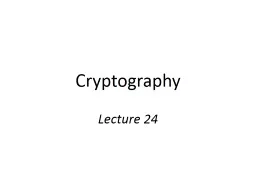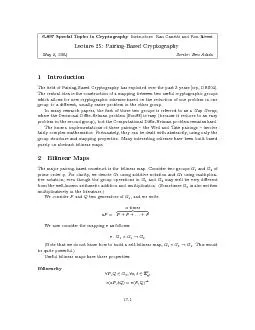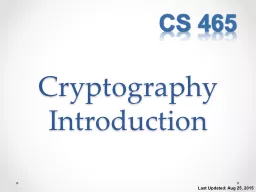PPT-Cryptography Lecture 24 Concrete parameters?
Author : vamput | Published Date : 2020-06-22
We have discussed two classes of cryptographic assumptions Factoringbased factoring RSA assumptions Dlog based dlog CDH and DDH assumptions In two classes of groups
Presentation Embed Code
Download Presentation
Download Presentation The PPT/PDF document "Cryptography Lecture 24 Concrete paramet..." is the property of its rightful owner. Permission is granted to download and print the materials on this website for personal, non-commercial use only, and to display it on your personal computer provided you do not modify the materials and that you retain all copyright notices contained in the materials. By downloading content from our website, you accept the terms of this agreement.
Cryptography Lecture 24 Concrete parameters?: Transcript
We have discussed two classes of cryptographic assumptions Factoringbased factoring RSA assumptions Dlog based dlog CDH and DDH assumptions In two classes of groups A ll these problems are believed to be hard ie to have no polynomialtime algorithms. http://www.artisticconcretegroup.com/ Our dedication to quality, combined with the characteristic beauty and strength of our products, make our slogan a reality: It's not an expense; It's an investment! And yes, we remain customer service fanatics. 897 Special Topics in Cryptography Instructors Ran Canetti and Ron Rivest Lecture 25 PairingBased Cryptography May 5 2004 Scribe Ben Adida 1 Introduction The 64257eld of PairingBased Cryptography has exploded CS 465. Last Updated. : . Aug 25, 2015. Outline. Provide a brief historical background of cryptography. Introduce definitions and high-level description of four cryptographic primitives we will learn about this semester. Andy Malone. CEO & Founder. The Cybercrime Security Forum. Explaining the Unexplained: Part One. Andrew.malone@quality-training.co.uk. SIA400. Note: . Although this is a level 400 session. It is designed to be a training session providing history, development and practical uses of Cryptography and as such if you already consider yourself an expert in cryptography then this session will be 300 Level.. Algorithms. Scott Chappell. What is Cryptography?. Definition: the art of writing or solving codes. Basic Encryption Methods. Caesar Shift. Simple Substitution Cipher. Fun to use, but are easily cracked by computers and even by humans. Josh Benaloh. Tolga Acar. Fall 2016. November 8, 2016. Practical Aspects of Modern Cryptography. 1. What is Money?. 106 billion people lived. 94% are dead. Most of the world’s wealth made after 1800. CSE3002 – History of Computing. Group A: Daniel . Bownoth. , Michael Feldman, Dalton Miner, Ashley Sanders. Encryption. The process of securing information by transforming it into code.. Encrypted data must be deciphered, or . 1. Part I: Crypto. Part 1 . . Cryptography . 2. Crypto. Cryptology . . The art and science of making and breaking “secret codes”. What is cryptography?. Ceasar. Cipher. Public key cryptography. What is cryptography?. Cryptography. or . cryptology. (from . Greek. . κρυπτός. . kryptós. , "hidden, secret"; and . A. Pier. B. continuous footing. C. steeped continuous footing. D. grade beam. A type of footing commonly used to support poured concrete or concrete block walls is a ______.. A. Pier. . B. continuous footing. 1. Administrative Note. Professor Blocki is traveling and will be back on Wednesday. . E-mail: . jblocki@purdue.edu. . Thanks to Professor Spafford for covering the first lecture!. 2. https://www.cs.purdue.edu/homes/jblocki/courses/555_Spring17/index.html. Concrete for Box Culverts – Wet Cast Concrete Joseph A. Daczko, FACI – BASF Construction Chemicals Presentation Outline Many Performance Demands on a Concrete Mixture Wet Cast Box Culverts Specifications and Production Requirements 18th December 2002, Ankara. „CONCRETE ROAD CONSTRUCTIONS . State of the Art and new Development“ . by. Jürgen Halm. HeidelbergCement Technology Center GmbH. Department Concrete and Application. Martin Concrete is one of the most reliable concrete construction companies that you can contact if you wish to get help from concrete contractors.
Download Rules Of Document
"Cryptography Lecture 24 Concrete parameters?"The content belongs to its owner. You may download and print it for personal use, without modification, and keep all copyright notices. By downloading, you agree to these terms.
Related Documents














